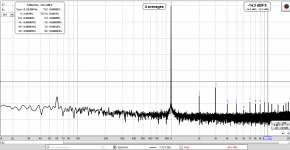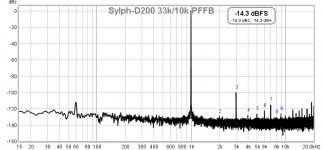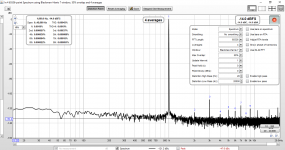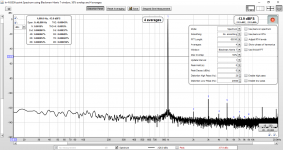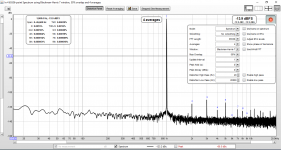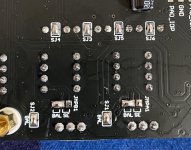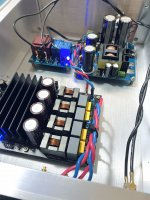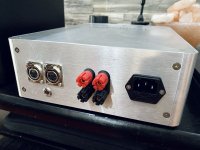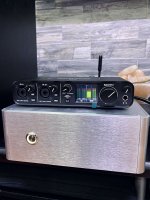D
Deleted member 148505
Hi Vito,
Thanks for the purchase, for the latest shipments, no tweaks are needed.
You cannot eliminate input coupling caps.
If you don't like the Elna Silmic ii's sound signature, replace the input coupling caps (C1-C4) with WIMA MKS2B044701K00KSSD..
Or use 4.7uF, 5mm pitch, 7.5x7.5mm sized polypropylene capacitors.
Use correct soldering temp to preserve the pcb traces. (not too hot)
If you have a thick sounding DAC/source, no need to bypass the buffer. Just use opa1656. The built-in buffer uses ultra low noise power supply and has a very good THD performance.
Regards,
Lester
Thanks for the purchase, for the latest shipments, no tweaks are needed.
You cannot eliminate input coupling caps.
If you don't like the Elna Silmic ii's sound signature, replace the input coupling caps (C1-C4) with WIMA MKS2B044701K00KSSD..
Or use 4.7uF, 5mm pitch, 7.5x7.5mm sized polypropylene capacitors.
Use correct soldering temp to preserve the pcb traces. (not too hot)
If you have a thick sounding DAC/source, no need to bypass the buffer. Just use opa1656. The built-in buffer uses ultra low noise power supply and has a very good THD performance.
Regards,
Lester
I bought my Sylph-D200 that is on the way.
What are main tweaks to do?
I would to eliminate electrolytics coupling caps. Any suggestion?
I already own a preamp XCCS BOSOZ that works well with my actual 3e-audio in balanced mode, do you think is the best solution or maight be something better?
With opa or with opa bypassed?
Output caps?
Thanks
D
Deleted member 148505
Also use a decent power supply to get the most out of Sylph-d200. My personal choice for the cheapest power supply is the lrs-350-36. Though you need a large chassis for it.
Sylph-d200 (latest tweaks) combined with a good power supply should have the smoothest highs in a TPA3255 based amp.
Sylph-d200 (latest tweaks) combined with a good power supply should have the smoothest highs in a TPA3255 based amp.
D
Deleted member 148505
D
Deleted member 148505
I remember had a look on them but unfortunately there are not compatible to be solder on JleTiCore
It is a bit tricky to solder pmlcaps, you must solder with low temperature
and put two little legs of wire in the throughole of the original couplingcaps to connect with the pml's. I use 4,7uF 25V.
But the soundquality ist phantastic.
No comparison to mks/mkp/elna silmic etc.
Just in an other league.
and put two little legs of wire in the throughole of the original couplingcaps to connect with the pml's. I use 4,7uF 25V.
But the soundquality ist phantastic.
No comparison to mks/mkp/elna silmic etc.
Just in an other league.
It is a bit tricky to solder pmlcaps, you must solder with low temperature
and put two little legs of wire in the throughole of the original couplingcaps to connect with the pml's. I use 4,7uF 25V.
But the soundquality ist phantastic.
No comparison to mks/mkp/elna silmic etc.
Just in an other league.
Hello you say remove elna silmic and put a pmlcap from rubycon?
Witch value? Why 4,7 uf and not 10 uf?
hi vitopro,
you can take every value between 4,7 and 10uF because that don't touch the hearing spectrum.
you can take every value between 4,7 and 10uF because that don't touch the hearing spectrum.
D
Deleted member 148505
Received the TRS connectors just now. I can get 0.0008% THD+N loopback measurement with 2.5Vrms input/output on my Motu M4.
Here's a quick measurement of Sylph-D200 with 33K/10K PFFB value (gain is around 11.5), 450kHz switching freq, and 36V DC using LRS-350-36
Using Motu M4 monitor out #2 , and line in #4
I'm using my soundcard interface with INA134 + OPA1656 to protect the Motu M4.
4.5Vrms = 0dBc
5W 4ohms
THD = 0.00095
THD+N = 0.0021
Looks like I need to use an external oscillator rather than using Motu M4's line out to get more performance.
Here's a quick measurement of Sylph-D200 with 33K/10K PFFB value (gain is around 11.5), 450kHz switching freq, and 36V DC using LRS-350-36
Using Motu M4 monitor out #2 , and line in #4
I'm using my soundcard interface with INA134 + OPA1656 to protect the Motu M4.
4.5Vrms = 0dBc
5W 4ohms
THD = 0.00095
THD+N = 0.0021
Looks like I need to use an external oscillator rather than using Motu M4's line out to get more performance.
Attachments
Last edited by a moderator:
D
Deleted member 148505
D
Deleted member 148505
PFFB changed to 18K/2K, lowered gain to 8.9
Motu M4 Balanced out -> Sylph-D200 -> JLE Interface -> Motu M4 SE input (Line In 4)
5W 4 ohms
-------------
THD = 0.00040%
THD+N = 0.0015%
SINAD = 96.5dB
Motu M4 Balanced out -> Sylph-D200 -> JLE Interface -> Motu M4 SE input (Line In 4)
5W 4 ohms
-------------
THD = 0.00040%
THD+N = 0.0015%
SINAD = 96.5dB
Attachments
Has anyone tried using the XRK Audio BTSB Buffer with the JLE board (or any other TPA325x board). Depending on the version, this provides a true Balanced Buffer using LM47924 or OPA1637 Op-Amps and also offers some optional gain if required.
.
.
So after a long journey I finnaly got my SYLPH-D200 module. First impression- it looks extremely well made, with perfect attention to any detail. It also sounds great- powerful and quite natural in sound (very firt impression).
I do have two questions-
1. I would like to compare PFFB vs non-PFFB. How to enable the PFFB in the latest module?
2. Is it OK for the module to work w/o load? in case I want to switch the speakers to another amplifier during operation- will speakers disconnection during operation can har, the module in any way?
Regards,
Aviv.
I do have two questions-
1. I would like to compare PFFB vs non-PFFB. How to enable the PFFB in the latest module?
2. Is it OK for the module to work w/o load? in case I want to switch the speakers to another amplifier during operation- will speakers disconnection during operation can har, the module in any way?
Regards,
Aviv.
D
Deleted member 148505
Hi Aviv,
You can enable PFFB by putting a solder jumper on SJ3, SJ4, SJ5, SJ6 (pic below for PFFB & Balanced configuration)
For non-PFFB, there is no problem if there is no load connected.
For PFFB I would be cautious on running it without load. (Specially if there is a source connected, and has a music output)
You can drill a hole under the aluminum chassis / casing so that you can enable/disable PFFB without disassembling the whole module.
You can enable PFFB by putting a solder jumper on SJ3, SJ4, SJ5, SJ6 (pic below for PFFB & Balanced configuration)
For non-PFFB, there is no problem if there is no load connected.
For PFFB I would be cautious on running it without load. (Specially if there is a source connected, and has a music output)
You can drill a hole under the aluminum chassis / casing so that you can enable/disable PFFB without disassembling the whole module.
So after a long journey I finnaly got my SYLPH-D200 module. First impression- it looks extremely well made, with perfect attention to any detail. It also sounds great- powerful and quite natural in sound (very firt impression).
I do have two questions-
1. I would like to compare PFFB vs non-PFFB. How to enable the PFFB in the latest module?
2. Is it OK for the module to work w/o load? in case I want to switch the speakers to another amplifier during operation- will speakers disconnection during operation can har, the module in any way?
Regards,
Aviv.
Attachments
Hi Lester,
Thanks for the info. Regarding SJ3-6, are they part of the signal/feedback path so I have to be carefeful regarding EMC considerations (i.e. solder as shost as possible) or they are just control signals so I can solder a mechanical jumpers/swich?
Regards,
Aviv.
Thanks for the info. Regarding SJ3-6, are they part of the signal/feedback path so I have to be carefeful regarding EMC considerations (i.e. solder as shost as possible) or they are just control signals so I can solder a mechanical jumpers/swich?
Regards,
Aviv.
D
Deleted member 148505
D
Deleted member 148505
- Home
- Amplifiers
- Class D
- JLE TPA3255 Build and Modifications

